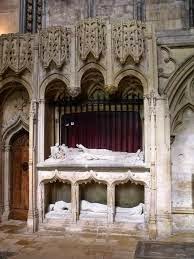Richard III, Kingship, Religion and the World Today
piece that was more often than not quite magnificent.
Edward IV's is a fine tomb, Henry VII's in particular stands out and Henry VIII's would have been grand if he had got his act together and spent less of his father's money. The greatness of a royal tomb is a fine example of royal breast beating
and loud shouts of "take note of how great I once was." You can be sure that many a king did not worry too much about the consequences of what they did in life, however they were extremely worried about these consequences once they had
shuffled off their mortal coil, this does not apply just to the monarch, it applied to most of the nobility too.
The wealthy saw to it that the clergy were paid to light candles on a daily basis once they were entombed, and then
yearly on the anniversary of their deaths. More importantly they made sure that prayers were offered for their souls. Fear of eternal damnation was the main driving force behind medieval and Tudor funeral art.
of their lives by opting for the Transi tomb. Bishop Robert Flemings tomb can be found in Lincoln Cathedral and
John Fitzalan's at Arundel Castle. Alice de la Pole's tomb at St Mary's Church, Ewelme in Oxfordshire is magnificent.
So today, as in the past, the choice of a tomb for an English King has to be made and this is yet another chapter in the journey of the remains of King Richard III. How many of us have become saddened and disappointed by the way this journey has descended into squabbling, back biting and side taking, we may as well be reading a book on the War of the Roses,
its the Percey's verses the Neville's all over again. And now we have a new addition to the latest controversy, a new tomb design, and I seem to be the only one who actually likes Leicester Cathedrals design.
The choice of a tomb for Richard III should reflect three things, his kingship, his religious beliefs and the world today, and I think that this design doe's just this. The simpleness of this new design, I feel, is a reflection of the latter, after all we are living in a country were many people have little and a world where the vast majority have nothing, a fancy tomb will not do. The deeply incised cross is a symbol of Richards faith and a reminder that Richard and his contemporaries were religious people even if we are not. Lastly the base has, placed within it, three Ricardian icons, the boar, Richard's motto and the white rose, a representation of his early life and his kingship.





 RSS Feed
RSS Feed
